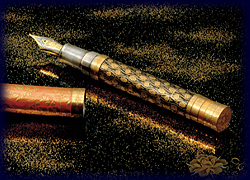WIT Life #152: Kaga Maki-e
WITLife is a periodic series written by professional Writer/Interpreter/Translator Stacy Smith (Kumamoto-ken CIR, 2000-03). She starts her day by watching Fujisankei’s newscast in Japanese, and here she shares some of the interesting tidbits and trends together with her own observations.
Recently I had the opportunity to interpret for a delegation from Kanazawa that was here to promote the city in general and especially its ancient craft of 蒔絵 (maki-e), a lacquerware technique that uses silver and gold powder. This art form actually originated in Kyoto which has its own style known as Kyo Maki-e, but the Kanazawa version is called Kaga Maki-e, Kaga referring to the area of Kanazawa where it originated. This picture, courtesy of fashion blogger Alice Chin, shows two delegation members at the ribbon cutting ceremony for the new Kaga Maki-e display.
On the left is native New Yorker and long-term Kanazawa resident Evelyn Teploff-Mugii, a designer who has modernized the thousand year old maki-e process to make breathtakingly beautiful accessories. Her Evelyn Claude line will be offered in the US for the first time. To her right is Kenji Yoshii, President of the Cooperative Association for Promotion of Kanazawa Kaga Maki-e. He works to use this traditional craft as an appeal point to bring visitors to Kanazawa.
Last night the group hel d an event to celebrate the launch of an online membership group called Club Kanazawa. You can enroll for free and receive access to travel professionals who can tailor your visit to Kanazawa to your needs. They can find you the exact kind of ryokan you want to stay at, introduce you to a historical sake maker and have you visit the brewery, or let you observe a maki-e craftsman and have him create a customized piece just for you. They are looking to create an image of Kanazawa as a brand that is distinct from the typical tourist spots of Tokyo and Kyoto. Here in this 400,000 person city, you can have unique traditional experiences that are hard to find elsewhere in Japan.
d an event to celebrate the launch of an online membership group called Club Kanazawa. You can enroll for free and receive access to travel professionals who can tailor your visit to Kanazawa to your needs. They can find you the exact kind of ryokan you want to stay at, introduce you to a historical sake maker and have you visit the brewery, or let you observe a maki-e craftsman and have him create a customized piece just for you. They are looking to create an image of Kanazawa as a brand that is distinct from the typical tourist spots of Tokyo and Kyoto. Here in this 400,000 person city, you can have unique traditional experiences that are hard to find elsewhere in Japan.
Guests mixed and mingled, enjoying sushi and other Japanese cuisine as well as local sake brought from Kanazawa. Especially popular was the Renaissance Kanazawa sake, whose translucent blue bottle and sweet taste made it a big winner. Speaking of sake, check out this article from today’s NYT which talks about the importance that sake suppliers place on the back story in terms of making certain sakes memorable for their customers. One interesting quote questioned whether sake’s draw is in the legend or the actual taste: “Sometimes when you hear the story, you’re drinking the story as much as you’re drinking the product.”


Comments are closed.